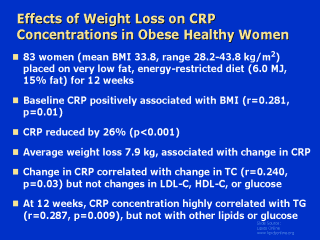 |
In 83 healthy
obese women (mean BMI 33.8 ± 0.4 kg/m2, range 28.2–43.8 kg/m2),
CRP was positively associated with BMI at baseline (r=0.281, p=0.01). Subjects with CRP
below the median of 5.8 mg/L had significantly lower BMI at baseline (33.0 ± 0.5 kg/m2)
than subjects with CRP above the median (BMI 34.8 ± 0.6 kg/m2; p=0.02). BMI
accounted for 7.7% of variability in baseline CRP (p=0.01). After 12 weeks on a very low
fat, energy-restricted diet (mean 5700 ± 60 kJ/d, 14.2 ± 0.2% fat), CRP was reduced by
26% (p<0.001). Average weight loss was 7.9 ± 0.3 kg and was associated with change in
CRP. Change in CRP was also correlated with change in total cholesterol (r=0.240, p=0.03)
but not changes in low-density lipoprotein cholesterol (LDL-C), high-density lipoprotein
cholesterol (HDL-C), or glucose. At 12 weeks, CRP concentration was highly correlated with
triglyceride concentration (r=0.287, p=0.009), but not with other lipids or glucose at
baseline or 12 weeks. Reference:
Heilbronn LK, Noakes M, Clifton PM. Energy restriction and weight loss on very-low-fat
diets reduce C-reactive protein concentrations in obese, healthy women. Arterioscler
Thromb Vasc Biol 2001;21:968-970.
Web
site |
